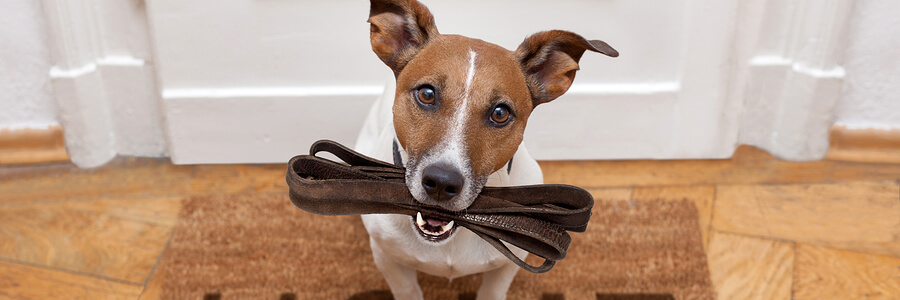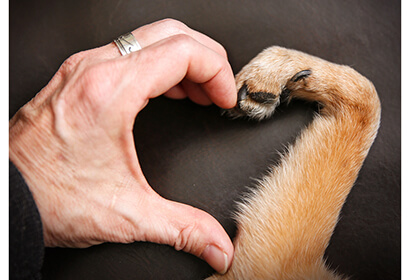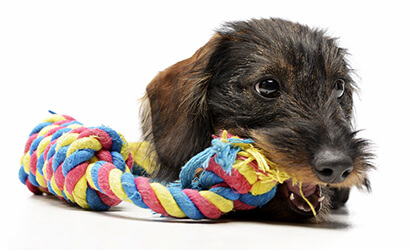
Training Dogs
Training your animals is important. Not only does this make your life easier when you can command them to behave, it can stimulate the animal’s mind, helping to keep them sharp. Many people wonder what the earliest age is to begin training their dog, but what just as many people don’t realize is that if the dog is conscious, he or she is already learning and taking in information. It’s up to you to feed them the information that they need to learn your commands.
Puppies can even be taught from the exact day that they’re taken home. If dogs learn commands early on, they are more likely to retain them as they grow older. Without training bad habits out of your dog when they are puppies, the dogs will simply learn that it is okay to pester their owners for the rest of their lives, simply because they have not been told otherwise.
What about when you adopt an older pet, though? Can a dog be too old to be trained? The short answer is no; any dog can be trained if it is motivated, and if the person that is training it has the perfect amount of patience, knowledge, and skills. This means, in fact, that you can teach an old dog a new trick!
So long as the dog does not suffer from some sort of cognitive dysfunction and is physically able, it should be able to be taught. Training techniques are generally going to be the same for any dog, no matter their age. That said, you should not wait too long to begin training; many people wait until a dog is six months to two years old to begin training them, which can make it harder.

What it comes down to is motivation and patience on both your behalf and your pet’s. Positive reinforcement is the main way that you are going to be able to train different animal behaviors. You must use a number of different exciting, fun, stimulating, and interesting rewards to teach them.
You must also be sure that you are training your pet in small increments and steps so that your pet does not become overwhelmed or frustrated. Begin by giving them your attention and rewards each time that they complete a step correctly. Be sure that you are not drawing attention to negative behaviors and only reinforce and reward the behavior that you want your pet to exhibit.
Watch how your pet behaves every day to determine what commands you want to teach your pet. For instance, if your dog likes to fetch toys, praise them when they bring you one.
Three Commands that Could Save Your Dog’s Life
When a pet owner starts training their dog, they are usually doing so to help them fix their manners or other behavior. Yet, training is able to do so much more than make your dog polite; teaching them a few commands could really save your dog’s life.
"Drop It"
There are a number of items in your household that could harm your dog, and just as many food items that could pose a choking hazard, such as apple cores and chicken bones. One of the most common items that could poison a dog is a human’s prescription and over-the-counter medicines. Sometimes, all it takes is a single pill to harm a dog. For this reason, the "drop it" phrase is imperative. If a dog is not taught to drop whatever he has in his jaws immediately, he could end up swallowing the item before you can fish it out of his mouth. When a dog can "drop it," you can grab the item to avoid any disasters.
“Down, Stay”
When a dog can drop down onto the ground, no matter how far away his owner is, he will have a better chance of staying safe. Even search and rescue dogs are taught this command, no matter what they might be doing when their owner delivers it. Your dog could end up in a dangerous situation, such as being on the other side of the street with a car coming, and you could get him to stay right where he is to avoid danger.
“Come” When Called
Dogs are usually oblivious to what is going on around them that could pose danger, such as poisonous plants or cars. By teaching your dog to come to you no matter what, you can distract him when you see him getting too close to a bad situation. This is also great for a dog that likes to run out the door or get out of his collar.
How to Stop Puppies from Chewing on Your Shoes

When puppies are little, it can be cute to let them engage in bad habits such as chewing on old shoes. But once they get older, they keep chewing, and those old shoes could turn into expensive formal shoes. One of the main rules of raising a pup is to remember not to allow a behavior that you wouldn’t want them to show off when they are adult dogs. What a puppy does when she is little can likely become a habit when they reach adulthood. When dogs are adults, it can be harder to break them of bad habits than it can be to break a puppy of them.
Stop Bad Behavior Before It Begins
Most people who have raised puppies can look back on the early years and find things that they would change if they could. We always do the best we can by our pets, but sometimes mistakes happen. An error occurring when training your puppy doesn’t mean that you will have to deal with ruined shoes forever; it just means that you will have to be diligent in your retraining.
When you have a puppy, the best thing that you can do to stop unwanted behavior is to not let it begin. Prevent their efforts by taking away opportunities for them to involve themselves in such a behavior. This allows them the chance to be given the right outlets to channel their energy instead of channeling it into destructive behavior.
A Few Tricks to Get your Dog to Go Outside in the Rain
Dogs are strange in the way that they have a huge range of habits when it comes to the bathroom. Some dogs can go anytime, anywhere, no matter what kind of weather is about while other dogs are affected by the slightest change in their environments. Depending on what kind of climate you live in, this could pose a big problem. If you are having a hard time getting your dog to go potty in the rain, check out the tips below.
Make it Worth His Time
When you are teaching your dog to hurry up and go outside on command, it is important that you find out what your pet likes the most in order to give him a reward. For example, when dogs go outside, you can teach them to go by using treats, praise or petting. When it is cold, you can teach them that they can only reenter the warm house by going potty.
Dog Training tip, train dog in rain and wet ground – by Peter Caine
Pair the Command with the Behavior
You will want to start by telling him to go potty when the weather is normal. When your dog is getting ready to potty, say your cue. You can use a phrase like "be quick." When your dog does potty, immediately give him a reward. This can be something like a treat or praise or playing a game of fetch.
Don’t Give a Reward Until the Deed is Done
You can teach your dog to go quickly by not giving him a reward until he has completed the task. This may mean having to stand around beside him and not giving him attention until he is done. Without this kind of training, dogs may have very little reason to hurry up and go. Dogs can learn to hold their bladders, especially because their owners have accidentally trained them to by showing them that after they potty, the reward is over and they must go back inside.
How to Better Your Dog’s Manners

Dogs have a habit of, well, being dogs. If you want them to be more polite, such as when company is over or just in general, check out these tricks:
Make Eye Contact
In a dog’s mind, direct eye contact can be seen as a sort of challenge or a threat. It is for this reason that dogs are afraid of prolonged eye contact with a human. Since eye contact is a normal aspect of human life, it is something that your dog is eventually going to encounter. You can teach your dog to make eye contact and show them that it is positive. This can help your dog’s confidence and make them less afraid and less likely to act up when they are interacting with your house guests. This will reduce their stress and anxiety and help them to relax.
By making eye contact, it will be easier for you to get your dog’s attention and distract him away from negative behaviors. Instead of raising your voice when he barks, you can tell him to look at you and then offer a reward for doing so.
"Go to Your Spot"
One of the most helpful things you can teach to your dog is to go lay down in a certain spot, such as his bed, when you ask. Teach them this behavior in order to solve a number of issues, such as begging at the table or running out an open door. You can also use this command to steer your dog away from problematic behaviors like chasing a cat.
This command can also be helpful when you are with your dog and you need him to go to a certain area to get out of the way. This includes instances when you are cooking or bringing in groceries and do not need to be tripping over him as you work. This can also increase your dog’s sense of independence by showing that it is okay for him to be away from you for short periods of time.
Tolerating Touch
Teach your dog to be okay with and to respond to touch. This can allow you more than one way to grab your dog’s attention when he is acting out. Touch can redirect your dog when he is doing something you don’t want him to do. Training him to be touched by strange things can help him not be afraid of certain activities, such as cutting his nails.
Training Your Dog: The Basics

When you first set out to train your dog, it could be hard for you to figure out where to begin. Check out the five main commands that every owner should be teaching their pooch:
Sit
Sit is one of the simplest commands both for you to teach and for your dog to learn. This makes it a good choice to begin with. In order to teach a dog to sit, follow these steps:
- Hold up a treat and keep it close to your dog’s nose.
- Move your hand upward. Cause his head to lift up and follow the treat, making his rear touch the ground.
- Once he is sitting, say the word "sit."
- Give him the treat.
- Repeat this several times every day until your dog gets used to it. Then, you will want to reinforce what he has learned by asking him to sit before certain activities, such as going on walks, eating, or in any other situation that you want him to be calm for.
Come
This is a command that can help keep your dog out of danger. This is great for bringing the dog back if you accidentally let go of his leash or leave the door open. To train him to come, follow these steps:
- Put a collar and a leash on your dog.
- Bend down to his level. Say the word, "come," and gently tug on his leash.
- Once he has arrived, reward him by petting him and giving him a treat.
- After he has gotten the hang of it, take off the leash and practice the command in a safe area, such as a fenced-in yard.
Down
Down can be one of the trickier commands to teach a dog. This is because the position puts them in a submissive place. You can help encourage the behavior by ensuring that the training is positive and calm, especially with anxious dogs. To do this, follow these steps:
- Find a treat that has a strong smell and close your fist around it.
- Hold your hand up to his nose and let him smell it. Then, move it to the floor so that he follows the smell.
- Slide your hand on the ground to encourage the rest of him to go down with his head.
- Once he is laying down, say, "down," and give him the treat.
- Repeat this step every day. Don’t reward him if he sits up or tries to take the treat from your hand. Don’t push him to lay down, either.
Stay
Before you follow these next steps, be sure that your dog has already mastered "Sit."
- Ask your dog to sit.
- Open your hand and hold it in front of you while saying, "stay."
- Take a few steps back away from him and reward him for staying.
- Keep increasing the number of steps that you take away from him. Reward him for staying, even if he only stays a few seconds.
Leave it
Leave it is a good way to keep your dog safe when he gets curious and could put himself in a dangerous situation. Teach your dog that there is something better than whatever he is sniffing and teach him to ignore it.
- Put a treat in both of your hands.
- Show him one of the fists with the treat inside and tell him to, "leave it."
- Let the dog sniff, nose, paw, lick and bark at the treat to try to obtain it, but ignore what he is doing.
- After he stops trying, give him the treat you’re holding in your other hand.
- Only give the dog the treat when he moves away from the other hand and looks at you.
- Tell him to leave it again and put the less attractive treat onto the ground. Cover it up with your hand.
- Wait until the dog has ignored the treat and looks at you. Then, take away the "bad" treat and give him the better one immediately.
- Then, place the treat on the floor but do not cover it with your hand. Repeat these steps until you are able to do this while standing up.
8 Important Tips for Training Your Dog

Pay attention to your dog.
You will need to learn how to listen to your dog. If he seems uncomfortable meeting another dog or person, do not force him to do it. The dog is telling you he does not want to do it for some reason, and it is important that you respect him. Forcing him to meet other animals can cause aggression or other issues.
Give him a lot of affection.
Most people do not have issues with being obvious when they are unhappy with their pooches, but they all too frequently ignore when they are doing well. Ensure that you are giving your dog affection and attention when he is doing what he needs to be doing in order to reinforce the behavior.
Ensure he likes his treats.
Even if a bag says that the treats are for every dog, it does not mean that your dog, in particular, will like it. Some dogs are choosy about what they enjoy eating. Look out for what he enjoys to be sure that your training is effective.
Tell the dog what you need him to do.
Telling your dog "no" and leaving it at that often is not enough to get him to understand what he is doing wrong. Instead of simply saying "no," be sure that you are telling him what it is that you want him to be doing. For instance, if your dog jumps on people to tell them hello, don’t just say no; he might think that you want him to jump even higher. You want to give him something else to do, such as telling him to "sit."
Be consistent with your training.
When you are training your pup, you need to get as many of the people in your house involved so that everyone can help and be on the same page. For instance, if you are telling your dog, "get off" when he is on the furniture and someone else is telling him, "get down" and another person is letting him sit on the couch, how will he ever learn what to do?
Be realistic in what you expect from your dog.
When trying to change a dog’s behavior, understand it will take some time. You need to be realistic about what you expect your dog to do when learning new behavior. Normal dog behaviors like barking, jumping, and digging are going to take more time to untrain. This is especially true if your dog has been told since puppyhood that whatever that behavior happens to be is okay to do since you did not teach him otherwise when he was little.
Feed your dog a top quality brand of food.
It is important to give your dog a good diet that has the right amount of protein. For instance, if your dog hangs out and lounges in your home most of the day, you don’t want to overwhelm his body with protein like you might give to a dog who is very active.
Don’t bribe, but instead, reward.
Training your dogs with treats is not bribery. Dogs do what works for them, and if treats work, do it. Use the reward as reinforcement instead of hanging it over his head before he even does the trick or obeys the command. Give him the treat and the praise only after he has completed his task.
Training Your Cat (is not Impossible!)

Training your cat, while it may seem impossible, is certainly something that can be done. Changing a pet’s behavior is not simple, but it’s all a matter of how you are teaching him. The main thing that you need to be thinking about when you are teaching your cat new commands is motivation. Just like a dog in training, your cat needs to know that by doing certain things, he is going to get rewarded. Here are a few tips to consider when training your kitty.
Quell Your Expectations.
One of the beliefs that surround cats is the idea that they are only going to do what they want when they want with no care about what their owners may desire. Because of this, many cat owners might think that their pet is not one that can be trained. This is not true. Cats are very similar to humans in the way that they do what works out for them and they avoid things that do not. Much like people, cats behave in ways that give them some sort of pay off and avoid ones that do not. For this reason, you need to keep in mind that your cat won’t be doing anything simply to make you happy.
Find the Right Praise and Reward.
You need to pay off your cat in a way that means a lot to him. Do this by finding out what motivates your cat. Does he like certain toys or treats? If so, use them as a reward for doing what you asked. Ensure that you are giving him a number of different rewards in order to keep him from getting bored with your training.
Your cat also needs to think that his reward is going to be worth the effort he is putting forth to get it. Hard-to-train behaviors are going to need a bigger reward than tasks that your cat will find simple to stop doing. For instance, it is important to remember that a reward is only going to work to reinforce their behavior if the cat thinks that the reward is worthy. While you might think your way of rewarding the cat is enough, they might disagree. Identify the reward that means the most to him and use it.
Do not punish your cat.
In order to motivate your kitty to keep learning, reward his positive behavior instead of condemning his negative behaviors. Punishment usually just stresses your cat out without solving the behavioral problem at hand. Do not spray him with water when he claws the couch; all that does is tell him that you are an unpredictable threat. Your cat will still scratch, but he will do so where you cannot see him.
Ensure that you are not inadvertently creating a negative correlation for your cat. This means that cats learn through experience, and if your cat learns that hearing you say his name means that he will get a treat, he will be more likely to approach you when you call him. That said, if when your cat hears his name, he knows he is going to get a pill, he is not going to want to come to you. You need to make negative actions like giving pills or trimming nails stress-free actions. Avoid asking for behaviors right before a situation is going to occur that your cat may not like. You can offer a high-value treat for the desired behavior instead. Eventually, your cat will learn that doing something she does not like will give her tuna flakes, it will increase the chances of her wanting to do so in the future.
Teach Your Cat to Come to You.
In order to teach your kitty to come when called, you need to teach them a verbal cue. Give the cue right before engaging in an activity that already gets your cat’s attention. Tell the cat to come right before opening the treat drawer, and once your cat approaches you, give the treat to them and reward them in another way as well.
Once your cat has mastered the "come" command, you can teach them how to respond to it all over the home and not just in the place where the treat drawer is. To do so, move slowly from one area to the next. Don’t go too far all at once. Call the cat and then engage in play with them in the new location while also giving them a treat.
Make Sure They are Rewarded.
Most importantly, you need to always be sure that your cat knows when she behaves how you want her to, something good is going to happen. Do not do anything that the cat is going to consider negative like trimming her nails right after calling her or she will not come anymore. Instead, go and find the cat when you have to do things that she thinks is negative.
Five Things to Stop Doing when Training Your Cat

1. Stop thinking that the cat will never learn.
Training takes a long time, but not as long as you might think that it does. The truth of the matter is that cats can learn at their best with a few short training sessions that last between one and five minutes at a time spread throughout the day. There is no need to make a specific training schedule; instead, just train them periodically like when you are waiting for your coffee in the morning. Training is going to be less successful when you incorporate it into your everyday interactions, such as playing or during meals.
2. Don’t ignore good behavior.
When your cat behaves in a way that you like, you need to stop taking it for granted. In the same vein, you likely react when he begins scratching at the sofa. This will just teach him that scratching the sofa is going to get your attention. Because of this, he will keep doing it. You can help stop this behavior by rewarding your cat when he does something right and ignore him when he is doing something wrong. When he uses the scratching post, reward him. When he scratches the sofa, redirect him.
3. Don’t try to stop instinctive behaviors.
Behaviors like pouncing, jumping, or climbing are a natural thing for a cat to do, but most humans do not like it. Trying to stop these natural behaviors can stress out your cat. Give them outlets to engage in these behaviors in ways that won’t make you upset, like giving them a cat tree to climb and jump into.
4. Stop expecting your cat to listen if you don’t reward them.
If you want your cat to do something, he needs to feel like it is worth the effort. Give him positive reinforcement in the way of catnip, treats or his favorite toys when he does something that you like, along with a verbal cue. Over time, the cat will associate the treat with the cue and be more likely to listen when you give a command.
5. Don’t set an unrealistic goal.
It is important to keep in mind that your cat is going to learn on his own and at his own pace. Pushing your cat to do too much at one time means you will be skipping the slow, positive reinforcement that he needs, which can just confuse and frustrate your cat and yourself. Keep your cat engaged but go slowly.
Can You Really Train Your Cat? | National Geographic Video
Affiliate message:
StuffPetsLove is an affiliate of several other sites, all with the best interest of your pet in mind. By being an affiliate, we are able to keep our site up and running to help provide you with important information on training, health and other aspects of a happy pet’s life. Our website is sustained through affiliation in order to allow us to bring you more informative articles and reviews!
